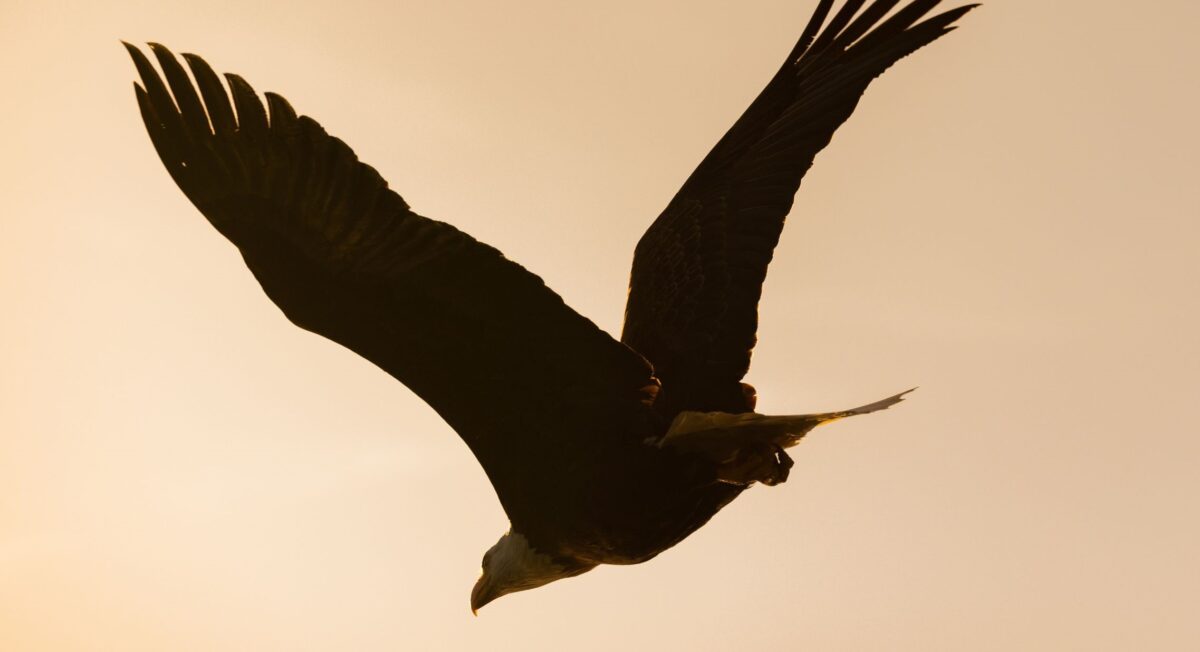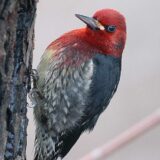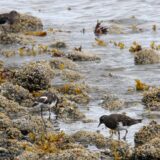QCL is a paradise for anglers however, there is so much more to QCL than what is underwater. The next time you’re at the Lodge take a moment to look beyond the tides and take in the unique beauty Haida Gwaii offers above water.
A secret known only to those who are looking for it, the area is home to incredible bird-watching opportunities. With unique species hiding amongst the forest’s edge, shorelines, rugged coastlines and diving down below the tides.
A few of our favourites to keep a lookout for are:
Holding a special place here in Haida Gwaii, the Eagle is one of the most recognizable soaring through the sky and hanging out at low tide.
Powerful and beautiful birds of prey, you’ll find upon reaching maturity these birds are dark brown with a white head and tail. Featuring a beak, feet and irises that are all yellow in colour, with highly developed talons to pierce their prey. Known as opportunistic feeders, these birds can be found wherever they can find something to eat – Whether that is along the shoreline or diving into bait balls.
- Raven
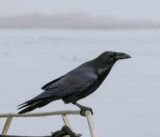
Also, culturally significant to the Haida people, the Common Raven is an all-black passerine bird that has co-existed with humans for thousands of years. This species is among the smartest animals in the world and is highly regarded among mythology.
The Ravens found in Haida Gwaii are some of the biggest globally, due to the colder weather. The iridescent plumage and dark brown irises that they feature are among a few of the distinguishable features. Look for these birds in trees along the coastline while out on the water.
Don’t let the name deceive you, this beautiful bird is a part of the Woodpecker species that regularly drill holes in bark to find food. Your best bet at sneaking a peek at the vibrant red head and breast is to head into the lush, old growth forest. Most often spotted near ground level, you’ll see them feeding on insects tucked away into the bark of Spruce and Hemlock trees.
A beautiful songbird that features a large, rounded head and a straight bill, and will most often be found amongst the trees. The male thrushes are dark blue-gray and rich burnt-orange with a soot black breastband and an orange line over their eyes., while females feature the same, but muted colouring. These beautifully coloured birds are mixed among the humid evergreens along the Pacific Coast.
A small and short shorebird, the Black Turnstone can be found along the rocky outcrops forming our little piece of fishing paradise. Identified by the dark black and brown colouring with a white belly and bold patterns only visible in flight, the mature adult’s individual white stripes on each wing, with a mostly white tail.
- Rhinoceros Auklet
A favourite at QCL, so much so that we named one of our freight boats after it – the Auklet.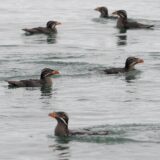
A seabird that is closely related to the puffin. Getting its name from the horned bill, this bird can be distinguished among the crowd through its cloudy gray colour, two white facial plumes and the thick orange-yellow bill.
An aquatic bird at heart, keep your eyes peeled while on the water as they are often in large flocks, swimming underwater as they chase prey.
- Tufted Puffin

Not as commonly seen but certainly a sight to behold if you do, the Tufted Puffin is one of two Pacific Puffin species. Sometimes called the Crested Puffin, this pelagic seabird is thriving with interesting facts – One of is that they nest mostly in deep burrows as it digs into cliff edges, they can get more than 1.5 meters deep.
Identify this bird by their long, pale yellow head plumes and intense red bill that offset the white face and black body. As they spend most of their lives on the open ocean, far from shore, Virago Sound is a perfect viewing spot.
Camouflaged by their dark bodies, and only noticeable by their red orange bills and eyes, and pale pink feet, the Black Oystercatcher goes after marine organisms that are left unprotected when the shore is visible.
Another species with interesting facts – the Black Oystercatcher was first described as being “blood-footed” due to the pink colour of its feet.
9. Harlequin Duck
Another beautifully coloured bird worth looking out for during your time on the fishing grounds is the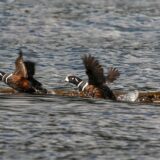 Harlequin Duck, a small sea duck that boasts many names. With striking plumage, the males are easily identifiable boasting a slate blue body, a white facial crescent, spot chestnut crown patching/flanks and bold white strips. Females are brown with similar telltale facial markings as the male.
Harlequin Duck, a small sea duck that boasts many names. With striking plumage, the males are easily identifiable boasting a slate blue body, a white facial crescent, spot chestnut crown patching/flanks and bold white strips. Females are brown with similar telltale facial markings as the male.
Like most ducks, they dive for aquatic invertebrates along the turbulent coastal waters. Keep a look out during the tide changes and wavy days as they favour white water.
10. Belted Kingfisher
Featured in our original logo, in 1991, the Belted Kingfisher holds a special place in not only our history but our hearts.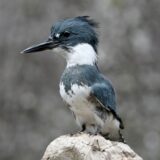
Blue-gray with a white band around the neck and under belly, the Kingfisher sports a large head with a shaggy crest. Females have a rusty band on their bellies, unlike the pure white and blue gray of males. Spending majority of their time perching along the edges of nearby water sources, these birds will hunt for small fish by hovering over the water and diving with their thick, pointed bill.
Around the Lodge, you can spot them when walking the trails and sometimes, they will perch amongst the trees on property. And if you look hard, you might even see a guest sporting a cap with the vintage logo.
These are only a few of the many birds that frequent Naden Harbour and Virago Sound. During your time at QCL, we encourage you to look beyond the tides, towards the skies to see how many you can identify.
Save this for reference and keep an eye out for what other adventures are yours for the taking while you experience fishing first class.

